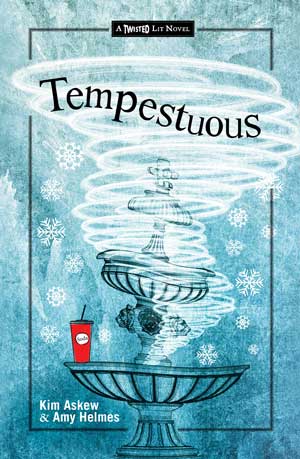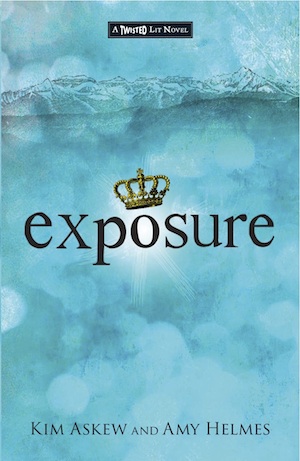
Whether you're still searching for a holiday gift for your choosiest bookish friend or a gripping read for yourself, may I recommend the new Twisted Lit series? With glowing reviews (even from Kirkus- "Death, betrayal, ruthless plots to seize the "crown"--all the seeds of stage tragedy take root and flourish in this clever modern-day homage to Macbeth.") and leading YA novelists Melissa Walker and Daria Snadowsky, it's no surprise that Kim Askew and Amy Helmes are the breakout, YA writing dream team of the year. After racing through their new books Tempestuous and Exposure from Merit Press, I can't wait to read their next novel. Read on for tales of their writing partnership, crafting novels based on their mutual love of the bard, and successful path to publication.
Nicki Richesin: Readers have enjoyed your wildly entertaining blog Romancing the Tome for years now. How did you first decide to blog about literary adaptations?
Kim Askew: I had only been living in L.A. for a few months when Amy and I first met. We were each thrilled to have stumbled upon another anglophile who adored Masterpiece Theater, period films, and afternoon tea. (This was long before Downton Abbey became a sensation.) We had a standing PBS-watching girls' night every Sunday for about three years, and then I decided to move back to San Francisco. We came up with the idea for the blog as a way to stay connected, even though we would no longer live in the same city. Naturally, it had to be about our mutual obsession: book-to-film adaptations.

NR: I know you've worked on other non-fiction book ideas together. Why did you decide to tackle writing for a young adult audience?
KA: We came to the conclusion that we really wanted to write fiction, and YA fiction seemed like it would be a blast to collaborate on. Every day we'd email each other a list of ideas for plots, and one day: Boom -- Shakespeare! It was a "Eureka" moment for us. We'd both been English majors in college, so we knew the Bard's works well and understood that they could be the basis for so much terrific material. Given Shakespeare's diverse body of work, we also knew it had series potential.
NR: Why do you think your Twisted Lit series, specifically writing books based on Shakespeare's plays, will appeal to the YA market?
Amy Helmes: We're told often enough that Shakespeare is "universal," and it's really true! Shakespeare, perhaps better than anyone, understood the idea of "adolescent angst," and we liked the challenge of finding ways to make his themes relatable to a contemporary audience, some of whom might find Shakespeare's works in their original form slightly terrifying. With two of us writing together, it was appealing to have something solid to start from -- a launching pad with which we could tell our own twists on the tales. We don't doubt Shakespeare would approve--so many of his works originated from other sources, too.
NR: Tempestuous follows the hijinks of Miranda Prospero after she and her friends are snowed in at their local mall. She's an outcast recently relegated to social pariah by the popular "It girls" at her school, but she undergoes a remarkable transformation with the help of her new friends. Why did you decide to set the novel in a shopping mall, and how did the plot development follow?
KA: We considered setting it on an island, just like in the play (potentially during Spring Break), but that seemed too literal a translation. We agonized for hours over this, but when we eventually decided to make a Midwestern shopping mall our "island," it just clicked. I worked at a mall in college, so I'm all too familiar with the monotony of the job. Three of my cousins actually worked at Hot Dog On a Stick when I was a kid, and they wore those uniforms, so that might have played a part, too. In The Tempest, the magician and banished king, Prospero, is transformed by events he himself sets in motion. That idea is what drove our plot. We decided our heroine would be a composite of both Prospero and his daughter, Miranda, so we combined elements of both those characters into one memorable young woman. We also had a very clear understanding of how Shakespeare's "Ariel" and "Caliban" ("Caleb," in our book) would factor in.
NR: Although your debut YA novel Tempestuous (Merit Press) will be published first (on December 18), you actually wrote Exposure (coming in Jan.) before it. Could you tell us a bit about the heroine Skye Kingston and how you decided to write a book based on Macbeth?
AH: Getting to play on the conceit of "the quest to become king" (or Prom King, in the case of our book) was too delicious to pass up! Macbeth is Shakespeare's darkest play, and we knew it would be a fun challenge to set it in the high school sphere, imbuing our novel with the same dark imagery. Macbeth was obsessed with his rank in the world and how he could catapult himself into a higher position. That pretty much sums up the social structure of high school in a lot of ways. Our main character, Skye, is an outsider looking in at the events as they unfold. The question became: how would someone react watching their best friend (and longtime crush) get caught up in a hellish web of treachery and lies?

NR: In both Tempestuous and Exposure, your heroines are teenage girls who are either under the social radar or in some essential way not conscious of their hidden potential. Why did you decide to explore this notion of realizing their true identity and what they're capable of for the first time?
KA: I think most teenagers don't see their true potential. (I'm a late bloomer, so I certainly didn't.). It's nice to be able to show our readers, through the characters, that other people feel the way they do, but that things can (and do!) eventually change. I'd love it if our books gave a reader a little more confidence to be herself (or himself). It's what I would tell my younger self if I could.
NR: I think it's fascinating that in both of your novels both Miranda and Skye are trapped, either in high school social circles or in the mall. This construction, like adolescence itself, of being trapped with little control over your life, is a typical theme in the YA world. Did you find this more interesting when writing your characters, not allowing them an easy escape from their problems?
AH: Yes, you're so right. Sometimes it seems one's only options in life are to stick one's head in the sand or take action. In Exposure, Skye is painfully shy and insecure, but by the end of the book she takes a very courageous step to free herself from her own self-imposed constraints. In Tempestuous, Miranda is almost too aware of her strengths and "powers" as it were. It takes being trapped in what she deems an untenable situation to finally teach her how to use her powers wisely.
NR: In Exposure, you were able to play with a bit of magical elements as in Macbeth. As readers we tend to categorize fantasy books as escapist reading, but in some ways it can make the reader engage with his or her world. Did you find writing about the fantastical more challenging?
KA: We chose to set the book in Alaska for just that reason. Though we wanted our book to be extremely rooted in reality, the remoteness of Alaska gives it that "otherworldly," isolated element that adds to the sense of mystery. Three of Skye's friends are Native Alaskans (Eskimos, in layman's terms). Aspects of their culture and belief system allowed us to weave in some of the mysticism from Macbeth. Readers can choose to see more in it, or not. But Macbeth wouldn't be Macbeth without the three witches!
NR: What can we expect next from the Twisted Lit series? Which of Shakespeare's plays are you definitely hoping to reimagine?
AH: We've already got a version of Romeo and Juliet in the works, which we wanted to address sooner rather than later because it's arguably the most beloved of Shakespeare's plays. But we also can't wait to develop our own "Prince Hal" from Henry IV, and Cordelia's dysfunctional family in King Lear certainly tempts us, too! The possibilities are fairly endless!
Nicki Richesin is the author and editor of Crush, What I Would Tell Her, Because I Love Her, and The May Queen. She is the San Francisco correspondent for Du Jour and a frequent contributor to Sunset, The Huffington Post, 7x7, Daily Candy, and The Horn Book. Find her online at www.nickirichesin.com.